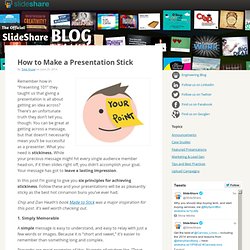

Some Strategies for the Preparation and Delivery of Oral Presentations. Tips for Oral Presentation Guy Kawasaki’s 10-20-30 Rule for Presentations. I have a confession to make: I have a man crush on Guy Kawasaki.

In all seriousness, his advice and wisdom that he has shared abundantly across the interwebs and through his books has changed my life. Specifically, his book, The Art of the Start, helped give me the insight and courage to get my company, Ethos3, off the ground. I’m a huge fan and am truly indebted. Back in 2005, Guy introduced to the world his 10/20/30 Rule of PowerPoint. It was applicable then and it is still just as practical today. 10/20/30 equals this: 10 Slides In the case of something like a pitch, he recommends keeping your slide count down to 10 slides. 20 Minutes Aim to keep the length of your presentation/pitch short. 30 Point Font Utilize big text and don’t be afraid to explore font sizes that are 350 point font or even larger.
If you are new to the world of public speaking or like to operate by a formula, then utilize this technique. Author Bio Related Posts. How to Make a Presentation Stick. Remember how in “Presenting 101” they taught us that giving a presentation is all about getting an idea across?

There’s an unfortunate truth they don’t tell you, though: You can be great at getting across a message, but that doesn’t necessarily mean you’ll be successful as a presenter. What you need is stickiness. While your precious message might hit every single audience member head-on, if it then slides right off, you didn’t accomplish your goal. Your message has got to leave a lasting impression. In this post I’m going to give you six principles for achieving stickiness. Chip and Dan Heath’s book Made to Stick was a major inspiration for this post. 1.
A simple message is easy to understand, and easy to relay with just a few words or images. Proverbs are great examples of this. Applying the idea of simplicity to presentations gives us practical rules like these: 12 Most Foolproof Ways to Keep People Awake During Your Powerpoint. Most people would rather face the electric chair than sit through a PowerPoint presentation.

This is fairly sound reasoning, considering most PowerPoints are capable of boring someone to death. Quick Practical, Tactical Tips for Presentations. In the past I’ve given some tips for handling meetings effectively, covering topics like: - How not to let your meeting go down a rat hole; - Dealing with the elephant in the room; - Dealing with skeletons in your closet; - How to make meetings discussions, not “pitches” - A tale of two pitches (I eventually invested in the first company that pitched) Today’s post is a subtle one about positioning yourself in a presentation.

This might be a VC meeting but also might just be a sales or biz dev meeting. It’s any meeting where you are in a small room and are being called on to present on some form of overhead slides 1. Sit closest to the projection screen – Many times a week I have entrepreneurs who do presentations for me and often I’m with some or all of my colleagues. If you look at Diagram A above you’ll see that the presenters are sitting at the opposite end of the table from where the screen is. 2. 3. 4. 5. 6.
Should You Approach Your Audience When Giving a Talk? Maybe Not - Andrew O’Connell. 10 tips for better slide decks. Aaron created this slide deck for a recent presentation on how TED’s tech team avoids problems by preparing well for all the possible pitfalls.

He picked this stunning image—of a container ship about to tip—to begin it. View the whole slidedeck from this presentation. Aaron Weyenberg is the master of slide decks. Our UX Lead creates Keynote presentations that are both slick and charming—the kind that pull you in and keep you captivated, but in an understated way that makes you actually focus on what’s being said out loud.
He does this for his own presentations and for lots of other folks in the office. We asked Aaron to bottle his Keynote mojo so that others could benefit from it. The big picture… Think about your slides last. And now some tactical tips… Go easy on the effects and transitions. 7 Data Presentation Tips: Think, Focus, Simplify, Calibrate, Visualize.
Comment pitcher en Silicon Valley ? [Partie 1/3] Serenpedia était présent au StartUp World 2014 organisé par VC TaskForce, dans le but d’y rencontrer quelques startups prometteuses.
![Comment pitcher en Silicon Valley ? [Partie 1/3]](http://cdn.pearltrees.com/s/pic/th/comment-serenpedia-francisco-84661435)
Comment pitcher en Silicon Valley ? [Partie 3/3] Serenpedia était présent au StartUp World 2014 organisé par VC TaskForce, dans le but d’y rencontrer quelques startups prometteuses.
![Comment pitcher en Silicon Valley ? [Partie 3/3]](http://cdn.pearltrees.com/s/pic/th/comment-serenpedia-francisco-84661465)
Ce fut également l’occasion d’écouter une brillante présentation de Bill Reichert de Garage Technology Ventures. Avant que certaines startups ne s’apprêtent à pitcher, il s’est exclamé : « What is wrong with all those elevator pitches nowadays ? ». Nous synthétisons dans cette série de 3 articles ce qu’il nous a appris. ► « C’est un beau roman, c’est une belle histoire… » Bill Reichert a signalé que les « templates » (tel que le modèle SVP évoqué en partie 2) c’est bien beau, mais ça fait tout sauf permettre de raconter une belle histoire.
The SVP Model. Slides Storytelling tools.